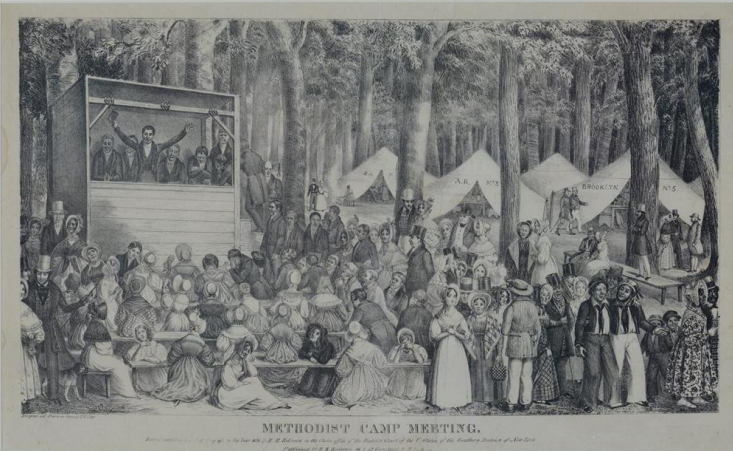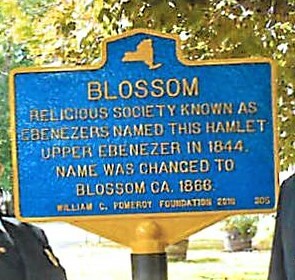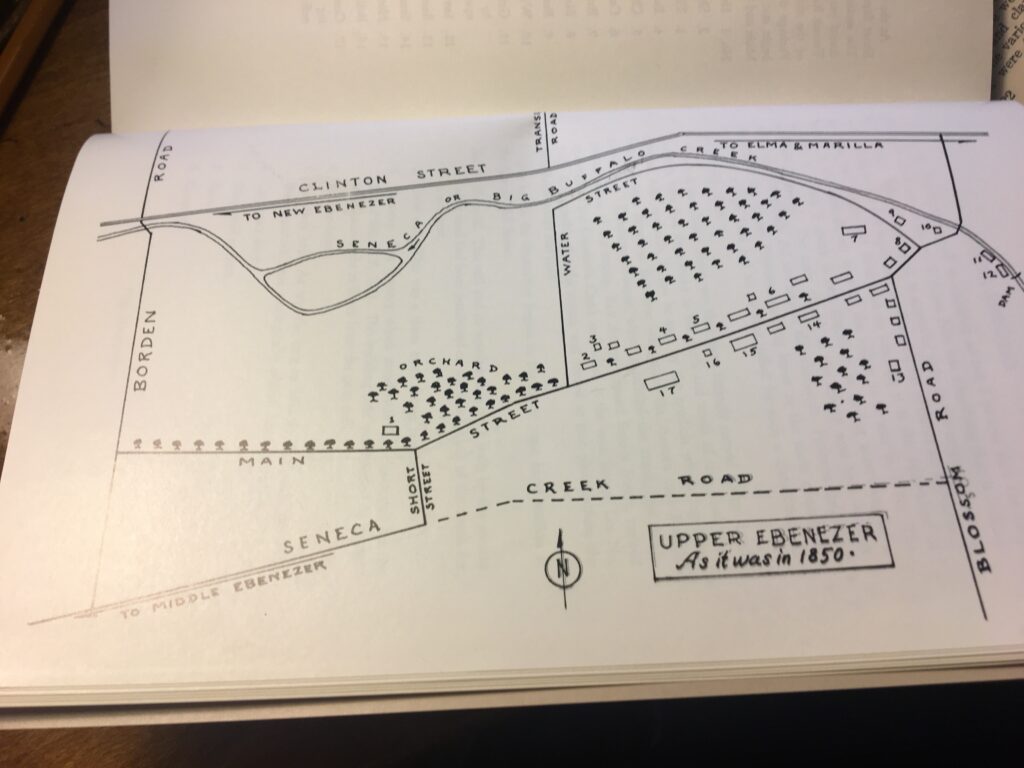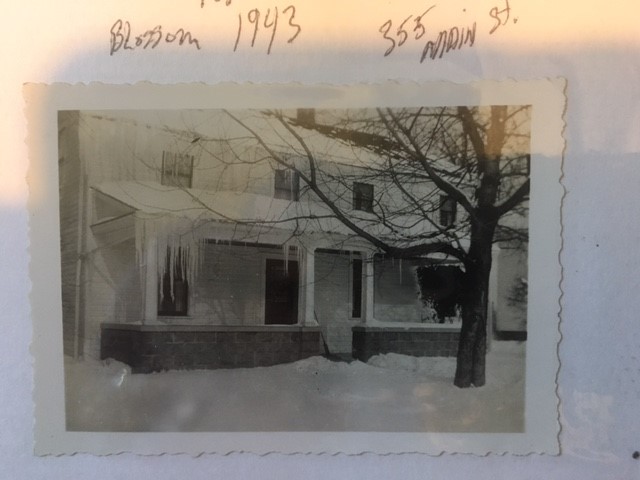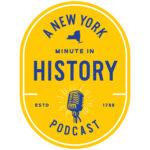
In this episode, Devin and Lauren discuss the “Burned Over District,” and how upstate New York became a “cauldron” of emergent religions and alternative communities during the 19th century. How did the Burned Over District collide with state and national history? And what role did the Erie Canal play in establishing it? Devin and Lauren also discuss how these new religions contributed to the creation of alternative communities, such as the Ebenezers and the Oneida Community, and how this predication for communal living was revisited in New York during the 1960s.
Marker: Blossom, Elma, Erie County, NY
Guests: Jack Kelly, author of Heaven’s Ditch: God, Gold and Murder on the Erie Canal; and Fred Strife of the Historical Society of the Town of Elma
A New York Minute In History is a production of the New York State Museum, WAMC, and Archivist Media, with support from the William G. Pomeroy Foundation. This episode was produced by Jesse King. Our theme is “Begrudge” by Darby.
Further Reading:
The Crucible of Ferment: New York’s “Psychic Highway, Emerson Klees (2001)
Communal Utopias and the American Experience: Religious Communities, 1732-2000, Robert P. Sutton (2003)
Upstate Cauldron: Eccentric Spiritual Movements in Early New York State, Joscelyn Godwin (2015)
Oneida Utopia: A Community Searching for Happiness & Prosperity, Anthony Wonderley (2017)
Teacher Resources:
The Organization of American Historians: Digital Classroom Resources: The History of Religion in the United States
The Center for the Study of Religion and American Culture: Teaching Resources
Communal Studies Association: Resources
Follow Along
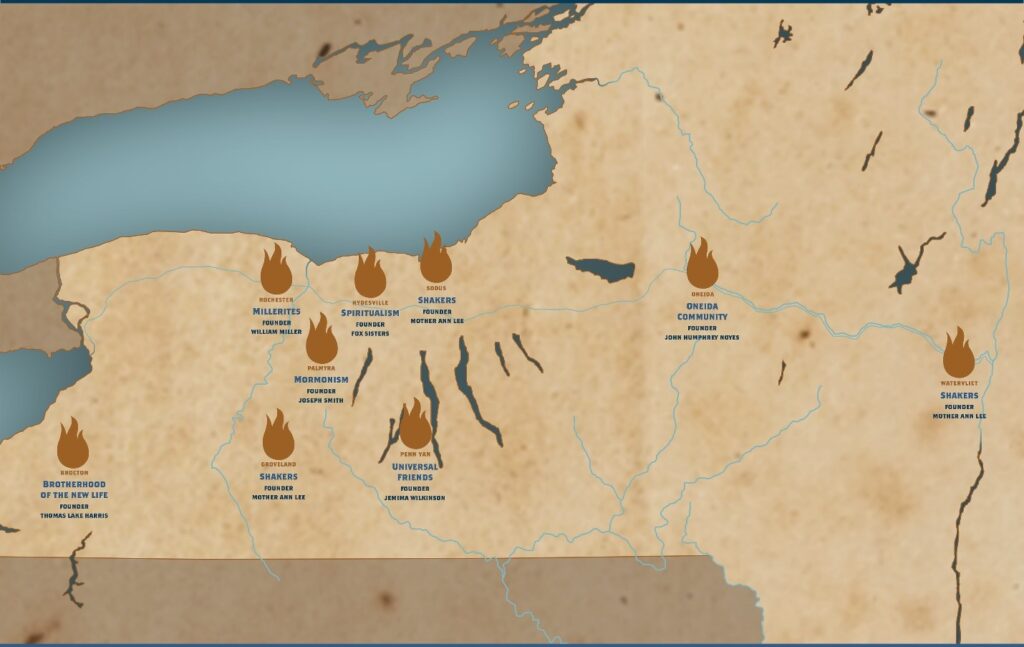
Devin: Welcome to A New York Minute in History. I’m Devin Lander, the New York state historian.
Lauren: And I’m Lauren Roberts, the historian for Saratoga County. This episode, we are focusing on a sign located in western New York, titled “Blossom.” The sign’s located along Main Street in the town of Elma in Erie County. The text reads: “Religious society known as Ebenezers named this hamlet Upper Ebenezer in 1844. Name was changed to Blossom circa 1866. William G. Pomeroy Foundation, 2016.”
So if you’ve never heard of the Ebenezers, you aren’t alone. This religious group, whose descendants are still in existence today, is also known as the Community of True Inspiration. They valued pacifism, they believed in simple worship, and they believed that chosen individuals served as instruments through which inspired messages were relayed from a divine power to the congregation.
The society was formed in Germany, and had a long history there beginning in the early 18th century. But there was also a long history of persecution: members of this religious sect, and we should note many other religious sects, faced incidents of physical violence and things like tax penalties due to religious intolerance. Christian Metz, who was the leader of the group, decided in the early 1840s that it was time for them to move to the United States, where they could practice their religion without persecution. Devin what was going on in western New York in the 1820s and ‘30s that would set that area up to be a desirable location where the Community of True Inspiration could establish a new society?
Devin: That’s a good question, and it really brings us to the topic that we’re going to discuss today, which is the “Burned Over District.” We have to remember that during this era of 1840s, when Christian Metz first came to this country with some of his followers, they arrived in New York City at first, and then they journeyed by boat up the Hudson River and hooked up with the Erie Canal. And that’s how they made it out to western New York near Buffalo. So my first answer to why was New York positioned as the Burned Over District (and we’ll talk a little bit more about what that actually meant), is really the creation of the Erie Canal. [Construction] began in 1817 and completed in 1825, and it really opened up all of western [and] central New York and beyond.
I should say, immediately, when we talk about “opening the lands,” that the lands were already settled. They were settled by the Haudenosaunee, who had been there for centuries and generations. And it was only by the forced displacement of these people that central and western New York were “opened” for settlement.
So we have a variety of things. We have the Erie Canal, which opened up markets from western and central New York to New York City. It also allowed people to come to the region, and at the time, there was a general mass migration from New England to central, upstate New York. New England, because it was settled so early by Europeans, started to become somewhat overpopulated. It was harder to acquire land, it was more expensive. Those who wanted their own farm and their own industry had a tougher time kind of cracking into that part of the East Coast. The combination of this immigration of New Englanders and the Erie Canal, which allowed for it, established some of the towns along the Erie Canal to really quickly grow in size – places like Rochester, Buffalo Creek and the city of Buffalo.
And the other thing we have to realize is that many of the settlers coming from New England were coming from religious traditions that emphasized differences with Catholicism, which was the dominant religion at the time. So these were Protestants and other sects. There was this mindset of, “We’re looking for a more pure type of religion, and in some cases, a complete alternative to the established religions of the time.”
Lauren: We spoke with Jack Kelly, author of Heaven’s Ditch: God, Gold, and Murder on the Erie Canal.
Jack: The Constitution had not only guaranteed the freedom to exercise religion, but it had banned the establishment of religion – and establishment in those days meant taking taxpayer money and paying the clergy and supporting the church in every town. So once that idea of an established church, a government-authorized and sponsored church, was gone, there was suddenly a big market for religions. Anybody could start a religion, all you had to do was attract enough followers. It opened up opportunities for both very sincere people and people that were a bit more marginal on the margins of charlatanism. Particularly along the Erie Canal, where people were moving into the frontier or moving away from the established traditions of New England.
Looking backwards, we’re a little bit deceived, because we have this image of a man with mutton chop whiskers, and prop coats, and, “Oh, that was great, great, great grandpa back then” – [an image of] an old man. But in fact, it was not an old man’s racket out there. It was mostly young people out looking for opportunity, looking for something new. For example, Rochester, New York – which was on the canal, and really was the first boom town that grew up along the canal (they invented the term “boom town” to apply to Rochester) – when it was booming, three quarters of the people were under 30. So it was really a youth movement.
I think just like young people, in any age, they were more open to change, more open to spirituality. They were searching as young people were in the 60s, searching for something new, something exciting, something that was emotionally gripping – and they found it in these various religious sects. So they had their cults, they had their communes. Finney was sort of the middleman between the really wild frontier versions of Christianity, and the very staid and traditional Puritan, Calvinist New England version. He had the ability to excite a lot of emotion to give an impression of heaven, hell, and Bible stories and so forth, with his preaching. [And he developed] the techniques of restrained emotion, I would put it that way. That was carried on by evangelists and revivalists all the way down to Billy Graham.
Devin: So that brings us to the person who actually came up with the term “the Burned Over District.” His name is Charles Grandison Finney, and he was a very popular evangelical preacher. He was a former lawyer, actually, who saw the light and became an evangelical preacher. And for a period of time he was based in Rochester, and he would go all around what we know as the Burned Over District and give revival meetings. And these would attract hundreds of people from all around the area. He was preaching a kind of perfectionism, a kind of religion that emphasized the emotional attachment, was less interested in ceremony, and more interested in taking the Bible very literally. And he was part of this early, what historians would call “the Second Great Awakening.”
Jack: The trouble with the term [“the Burned Over District”], was Finney said it was a “burnt district,” meaning there had been so many revivals that it was hard for him coming in to get up any interest in revivals, because people had essentially burned out on revivals. A lot of people take it to mean it was burning with religious fervor. So those two ideas really conflict.
Lauren: Finney brought to these rural communities something so exciting that was coming to town, you know? They were used to their regular Sunday sermons that were humdrum and maybe a little bit more ritualistic. But when Finney would come to town, he had this great oration skill. And there were physical things happening to their bodies, they talked about the transformation process. This would be an exciting event in their lives, that may not have had so much excitement before the introduction of the canal.
Devin: That’s a great point, they were certainly events. And it explains why some of the other movements that developed out of this area, that are more famous than the Ebenezers, including Mormonism, and the Millerites, later on the Oneida Community, by the mid-19th century, the Fox Sisters, and Spiritualism – all of these movements kind of happened in this one area. And the one thing that they have in common, many of them, is a really charismatic leader, right? Somebody who has the vision, who has the knowledge and is a direct conduit to God or to the spirit realm, and therefore is able to attract a following of people who not only understand and believe in the message, but really believe in the messenger.
Lauren: One of the other things that I think was attractive about this movement was, previously, you have the Calvinist belief in predestination, where you’re stuck with your lot in life – it’s already been determined, and you don’t have any individual control over it. When those ideas start to change, and you see the introduction of individual people having control over their life, whether they’re going to be a sinner or transform into a more perfectionist or pious life – I think that’s an attractive idea for people who had felt like they were stuck, and they had no control.
Devin: And many of these groups, including the Ebenezers, they saw themselves as the true believers of having the true word, and that the rest of society was doing things wrong. And that’s why they often lived communally. They would come together, and they would shut themselves off from the rest of society. And we see this with the Ebenezers going back to their founding in Germany, where they lived as a group – they may not have shared all of their wealth or anything, but they certainly lived together, and they shut themselves off from the rest of society as much as possible. There’s always some sort of economic transfer going on in many cases, but they were living by their own terms.
Lauren: So in 1844, Christian Metz, who we’ve talked about, was the spiritual leader of the group. He purchased 5,000 acres of land from the Ogden Company that had recently been part of a Native American reservation that was known as Buffalo Creek. However, things were not so smooth when the Inspirationists first came, because the Seneca Nation disputed the legitimacy of the sale. And it took several years, they went to the courts to try to settle this, and not surprisingly, the courts found in favor of the European purchasers and the Seneca were forced to move west to other reservations. Now, when Metz came over, there were about 800 followers who came with him from Germany. It was Metz who declared that the settlement would be known as the Ebenezer Society.
So I was wondering where the name Ebenezer came from, and if you go to the dictionary, the definition of Ebenezer is “a commemoration of divine assistance.” It refers to a stone that Samuel erected in commemoration of God’s help to the Israelites in their victory over the Philistines.
Devin: As you said, the original group consisted of over 800 residents who emigrated from Germany, and their land was divided into four villages: Middle, Upper, Lower and New Ebenezer. At first, the group kept their separate possessions, but over time, due to arguments between those with many possessions and those without, Metz convinced the residents to pool their resources and live truly communal, sharing everything except clothing and household goods.
Lauren: They didn’t have kitchens in the original houses, they had communal kitchens. So women would be the ones that were doing the cooking, then then they would eat communally in a dining hall or a separate building.
Devin: Yeah, I think that’s an important point, that they believed in strict separation of the genders – so men and women ate in different areas. They also took part in church services and town meetings separately. Schooling was separated by gender – boys and girls both went to school from about the age of six to 13 – but they were educated separately, and the teachers were all men.
Lauren: There’s a story that I learned from the town of Elma Historical Society about a structure that’s still there, it was an Ebenezer structure called “the prison house.” So apparently, it was a rule of the society that when a man and a woman were planning to be married, they had to be separated for a year before they could get married. But apparently, there was a young couple who didn’t want to abide by this rule, and they married secretly. When the ruling elders found out about this, they decided that their punishment would be that they had to remain in solitary confinement together in this house, now called “the prison house,” for a whole year. They were supplied with clothing and provisions, and the man was allowed to work in the woods, but there was no communication, written or spoken, between this couple and any of the outside world for an entire year.
Devin: They did not believe in the playing of instruments, they believed more about doing hard work about being pious to their beliefs. And about an austere form of living, where there weren’t celebrations, there wasn’t lots of singing and dancing – or any singing and dancing, really.
Despite their strict adherence to their beliefs, children and young adults tended to not leave the society, as they often did with other separatists. Even though they had an open door policy – you could leave, if you could not adhere to their rules, you were welcome to leave. But even if young adults did leave, they would often return, which helped really make them have a lasting effect. And they also created a series of industries over time. Of course, they had to start off with things like blacksmith shops, but they also developed textile mills, and saw mills, and grew produce that they would sell. And it was a way for them to be self-sufficient and provide for their community, which grew as more interested immigrants would come from Germany and join their society.
Lauren: I spoke with Fred Strife, a member of the Historical Society of the town of Elma. Fred is a lifelong resident of the hamlet of Blossom, which used to be called Upper Ebenezer.
Fred: I live just outside of Blossom, but we have an apartment there now that is one of the original Ebenezer houses, and that’s been in the family since about 1890. So basically, it’s just my turn to take care of it.
Lauren: Fred was able to describe for me what the buildings in Upper Ebenezer were like.
Fred: The house that I have was a bakery, originally four large rooms. At the time, it was quite a modern facility – it had a barn in the back, there still is a barn, with running water in it, which comes out of a spring out of the basement, and runs about 100 feet into the barn. There were cows, and actually my uncle had cows, donkeys, and ducks and chickens and things. Of course this is after the Ebenezers left, but we suspect that it was a very similar operation.
Apparently, they were so close to Buffalo that portions of their community, which is very religious, were breaking off and being “contaminated” by the modern world of Buffalo, which in the 1850s was tough. They were having problems with people in the area, and the 5,000 acres was getting populated, and they wanted more property, which was hard to come by at that time. Starting in 1856, the community started departing from Ebenezer. By 1861, Upper Ebenezer was abandoned.
Lauren: Even though it seems that the Ebenezer Society was thriving in their settlement, it was really kind of short lived in that area.
Devin: Absolutely. By 1854, Christian Metz was looking for more land in a more secluded area, and they found, in Iowa, 26,000 acres of land. After viewing those parcels of land, Christian decided that they would change their name, and they changed their name from the Ebenezers to Amana, which was named after a mountain in the Song of Solomon, again in the Old Testament.
Throughout the rest of the 19th century, Amana grew in size and developed a series of industries, including a soap and wool factory, a textile mill, a tannery, and flour and saw mills. But by the 1930s, the population had declined and the business interests of the group spun off into a separate corporation from the religious aspect. Today, the Amana Church Society, which is the religious side of the group, still exists, and has about 400 members. The business side has gone through many iterations over the years, the most famous of which is the Amana brand name of home appliances. So many of you may have an Amana appliance, refrigerator, dishwasher or something like that. That’s where it got its name from. Now, the Amana brand name is owned by Whirlpool.
Lauren: Back in western New York, after the Ebenezer Society had found their place in Iowa, the community began selling off their abandoned lands, which made room for more people to move into the area, which was primarily German immigrants. So in the 1860s, the hamlet which was formerly known as Upper Ebenezer started to be referred to as Blossom.
Fred: There was a gentleman by the name of Blossom, and he was apparently a lawyer and taking care of the sales of the properties owned by the Ebenezers. And [the name] may have been something to do with that.
And there was a few Ebenezers who actually stayed there – not in the village, outside the village. They had large portions of property that they purchased from the society. The houses are still there. There’s a number of houses that are still there. Just a side note, my aunt had lived there since the 1890s, when [she and her husband] first got married. She would always say, “Gee, I live in a town where the trees are always in blossom.” And it’s very pretty.
Lauren: Even though the Ebenezer Society was only active in western New York for about a decade, their presence there speaks to the larger movement of religious fervor and a tolerance for new ideas, which expanded in the area as a direct result of the construction of the Erie Canal.
Devin: Lauren, you asked me at the beginning of the episode why the Burned Over District became the Burned Over District, and why so many religions were either developed there or took root there (Like the Shakers, which obviously was not originally from New York, but took root in many of the places around the Burned Over District.). And I think it really goes back to this idea of perfectionism and utopianism, where many of these people believed that they could create a perfect society, even on a small scale.
And if you think about why New York, why the northeast, why the United States, it’s really interesting to start thinking about the very founding of the United States as a utopian movement. It’s something that Gordon Wood, the great historian, has suggested in some of his work on republicanism – that really, the founders of this nation were trying to create a better and more perfect, and virtuous society. And the founders really looked at Europe, specifically England, as being a place of decadence. And a place that was not virtuous and not pure, that had become over-reliant on the aristocracy, and the king, and all of these things. And that was certainly part of what they believed they were rebelling against.
Now, of course, we have to qualify that idea of utopia by stating that, really, it was a utopia for land-owning white men. This did not include women at the time. It obviously did not include the indigenous population that was already established on these lands. And it also didn’t include the enslaved. But the very fact that the ideals of the American Revolution did not include everyone, did not actually mean liberty for everyone, led to many of the social movements that came later, including the suffrage movement, and the abolitionist movement.
You know, it’s really interesting when you think about this explosion of communal societies and religious societies that took place, really, a generation or two after the Revolution – it was a combination of the technology of the Erie Canal, immigration from New England, the work of revivalists like Charles Grandison Finney and other preachers, but it was also just this general acceptance of alternative ideas that really made the Burned Over District possible.
Lauren: It’s interesting to look at also the backgrounds of the people who were starting these movements in the Burned Over District. If you take Joseph Smith, Finney, Metz – none of these people had money. They weren’t wealthy, they were all humble, some of them impoverished, and they didn’t have easy lives. And so I think when they look at traditional religions, like what was going on in New England, they saw religion where they didn’t have individualism or power, and it wouldn’t be in the stars for them to hold those positions. So when you start to develop these new ideas, and these new religions, the leadership was coming from a very humble place and difficult lives. And they were able to create this sense of belonging with other people who were a lot like them, who had been through the same difficulties who had labored all their lives – you know, one bad season of crops and they lost their farm, or lots of mothers who had experienced the deaths of many infants due to disease or poverty. The fact that these new people were coming up with religious ideas, and they looked a lot like you, was also instrumental to instilling a sense of belonging, and the idea that eternity was going to be better.
Devin: And again, we can extrapolate that out to the social movements as well. People like Gerrit Smith, who we investigated in our Timbuctoo episode, really believed that they could make a difference, and that they could help change society for the better. Elizabeth Cady Stanton – again, all of these people were in this region, the Burned Over District, around the same time, coming up with these radical ideas, really radical ideas for the time. You know, women should vote, women should be equal. That was a radical idea in 1848.
Lauren: And not one that the Ebenezers held.
Devin: Not one that the Ebenezers held, which is a very good point. And also the fact that African Americans should be free, should not be enslaved, should have basic rights as well. This idea of community, this idea of utopianism, and this idea of bettering society is all very radical in some level, but it’s all very American on another level.
Lauren: Thanks for listening to A New York Minute In History. This podcast is a production of WAMC, the New York State Museum, and Archivist Media, with support from the William G. Pomeroy Foundation.
Devin: A big thanks to Jack Kelly and Fred Strife for sharing their time and expertise. Our producer is Jesse King. I’m Devin Lander.
Lauren: And I’m Lauren Roberts. Until next time, Excelsior.
